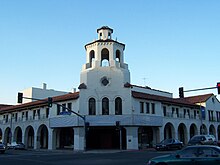Riverside Fox Theater
| Fox Theater | |
 |
|
| Address | 3801 Mission Inn Avenue Riverside, California United States |
|---|---|
| Owner | City of Riverside |
| Operator | Live Nation |
| Type | Movie palace |
| Capacity | 1,646 |
| Screens | 1 |
| Current use | Live event venue |
| Construction | |
| Opened | 1929 |
| Reopened | 2010 |
| Website | |
| www |
|
| Fox Theater | |
|---|---|
| Coordinates | 33°59′2″N 117°22′30″W / 33.98389°N 117.37500°WCoordinates: 33°59′2″N 117°22′30″W / 33.98389°N 117.37500°W |
| Architect | Balch and Stanbury |
| Architectural style(s) | Spanish Colonial Revival |
| Reference no. | 39 |
The Riverside Fox Theater, also known as the Fox Performing Arts Center, was built in 1929, and is a Spanish Colonial Revival style building in the heart of downtown Riverside, California. The theater is the centerpiece of Riverside's Arts & Culture initiative and underwent a major renovation and restoration to become a regional performing arts facility. Renovation was completed in the Fall 2009, with a grand-reopening in January 2010.
The theater is best known for being the first theater to screen the 1939 film Gone With the Wind.
The Riverside Fox Theater was designed by Los Angeles-based architects Clifford Balch and engineer Floyd E. Stanberry, who were responsible for designing many of the "West Coast Theaters," and later, Fox Theaters. The theater was part of a chain of West Coast theaters built by Abe and Mike Gore, Adolph Ramish, and Sol Lesser. This partnership constructed neighborhood theaters in the Southern California area throughout the 1920s. In 1928, this group sold a controlling interest to William Fox of Fox Studios and the corporation became known as Fox West Coast Theaters. This alliance with Fox created a seamless production to distribution system for the film industry. The partnership was short-lived, however, due to both antitrust regulations and Fox's own financial difficulties. The corporation went into bankruptcy in the early 1930s. The theater came under control of the Skouras Brothers in 1932 and became part of the National Theaters chain, the largest and most successful theater chain in US history.
Throughout the 1930s and 1940s, the Fox Theater was used by the Hollywood-based film industry to show previews of future releases before final editing. Riverside was considered a useful preview site because it represented, demographically, small town America. By previewing their future releases in Riverside, the film companies believed they could register the reaction to their movie within the country's largest viewing demographic without having to travel too far.
During World War II, the building served as a makeshift dormitory after the soldiers from the nearby military bases filled the city's available sleeping spaces. Manager Roy Hunt allowed the soldiers to sleep on the thick carpets of the lobby and auditorium. In 1942, the Fox Theater converted its stage and surrounding dressing rooms into a 536-person secondary theater named the "Lido," which served as a "second-run" film house for headline pictures. Alterations and additions to the original design included the small secondary theater in the former stage house, alterations to the proscenium and various new sound absorption finishes in the auditorium.
...
Wikipedia

